
-
Takayama City is in the north of Gifu Prefecture located in the centre of the Hida region and surrounded by Nagano, Toyama, Fukui and Ishikawa Prefectures. The city boundaries spread approximately 81km from east to west and 55km from north to south with an area of 2,177.67k㎡(around the same size as the Tokyo metropolitan area), making it the most extensive city in Japan. 92.3% of the area is forest and it is geographically divided by mountains, rivers, gorges and passes. It is rich in topographical variations such as a 2700m difference in heights above sea level.
In the north east area there are the Northern Alps (Hida mountain range) including Yarigatake, Hotaka-renpo and Norikuradake. Once the Takaharagawa and Miyagawa Rivers have divided, they flow north to the Jinzugawa River drainage system. In the south, there is Ontake mountain and the Hidagawa River flows from north to south into the Kisogawa River drainage system and in the south west area, the Shogawa River runs from south to north into the Shogawa River drainage system which is the source. The highest mountain is Okuhotakadake at 3,190m and the lowest is Kamitakaracho Yoshino at 436m. -
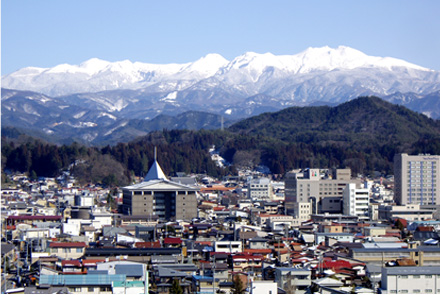
| Population: | 94,140 (as of June, 2010) |
| Area: | 2,177.67㎢ (east-west: approx. 81km/north-south: approx. 55km) |
| Location: | (Takayama City Hall) North latitude: 36º09"/East longitude: 137º16" |
| Climate: | Largely Sea of Japan climate with partial central high ground climate and overall continental climate.
Rainfall is low and there is a large annual range in atmospheric temperature. Summer is hot and the highest temperatures exceed 30ºC frequently. There is severe cold in the winter and it is not rare to have lowest temperatures that exceed -10ºC. |
| Jan | Feb | Mar | Apr | May | Jun | Jul | Aug | Sep | Oct | Nov | Dec | |
|---|---|---|---|---|---|---|---|---|---|---|---|---|
| Mean maximum temperature ℃(ºF) | 3 | 3.6 | 8.5 | 16.5 | 21.9 | 25.2 | 28.7 | 30.1 | 24.9 | 18.8 | 12.3 | 5.9 |
| (-37.4) | (-38.5) | (-47.3) | (-61.7) | (-71.4) | (-77.4) | (-83.7) | (-86.2) | (-76.8) | (-65.8) | (-54.1) | (-42.6) | |
| Mean minimum temperature ℃(ºF) | -5.5 | -5.7 | -2.5 | 2.9 | 8.4 | 14.3 | 18.5 | 19.3 | 15.1 | 7.9 | 2 | -2.7 |
| (-22.1) | (-21.7) | (-27.5) | (-37.2) | (-47.1) | (-57.7) | (-65.3) | (-66.7) | (-59.2) | (-46.2) | (-35.6) | (-27.1) | |
| Precipitation mm(inches) | 88.9 | 99.7 | 120.5 | 139.1 | 134.8 | 193.1 | 226.2 | 169.1 | 257.8 | 126.7 | 98.5 | 79.3 |
| (-3.5) | (-3.925) | (-4.744) | (-5.476) | (-5.307) | (-7.602) | (-8.906) | (-6.657) | (-10.15) | (-4.988) | (-3.878) | (-3.122) | |
| Snowfall cm(inches) | 166 | 155 | 66 | 7 | 0 | 0 | 0 | 0 | 0 | 0 | 15 | 98 |
| (-65.4) | (-61) | (-26) | (-2.8) | 0 | 0 | 0 | 0 | 0 | 0 | (-5.9) | (-38.6) |
| Region | Asia | European | North America | Latin America | Oceania | Africa | Total |
|---|---|---|---|---|---|---|---|
| Number of people | 72,190 | 45,220 | 15,380 | 3,560 | 10,560 | 1,090 | 148,000 |

-
The town of Takayama came into being in 1568 when a feudal lord of the Warring States Period, Nagachika Kanamori, entered Hida. Kanamori began to construct his castle in 1588 and to organize the castle town. Samurai residences on the elevated ground surrounding the castle and the lower down merchant town (currently the old town) were constructed and a number of temples and shrines were relocated to the east side foothills.
(Currently the Higashiyama temple town.) Further, he arranged roads stretching out in all directions from the castle town and made the town of Takayama function as the governmental and economic centre of Hida. The foundations of the current town of Takayama were created by the initiatives of Kanamori.
Hida came under the control of the Edo shogunate from 1692 and a magistrate's office (Jinya (Historical Government House)) was placed in Takayama. The castle and samurai residences were all demolished by the shogunate but the merchant town and the Higashiyama temples were left untouched and following this Takayama achieved development centered around a group of merchants called the 'assembly of masters'.
The divisions and roads in the centre of Takayama are, even now, almost exactly the same as they were 420 years ago. -


-
The castle and merchant town in the centre of old Takayama have been preserved since the Edo Period and because of this, it is called 'Hida's Little Kyoto'.
It is said that the place name of Takayama comes from the family of Taga, a guardian in the Eisho Period (1504-21). Geki Takayama constructed the fortress Tenjinyama, enshrined the spirit of Omi no Taga and called the enshrined mountain Tenjinyama/Tagayama.
At the command of Hideyoshi Toyotomi, Nagachika Kanamori repressed Hida in the 13th year of the Tenshou Period and, after rebuilding the castle on Tenjinyama, developed the castle town. During this time Kanamori compared the Miyagawa River that runs through the centre of the city to the Kamogawa River in Kyoto and constructed the Takayama of today with the temples in the Higashiyama district and the roads that divide the town in a grid pattern. -


-
The group of temples on Higashiyama 'Higashiyama Walking Course'
Kanamori, who stabilized Hida in the Warring States Period, while organizing the castle town, compared the foothills that stretch out to the east to Higashiyama in Kyoto and constructed and relocated a number of temples. The road that visits these temples which have prefecture- and city-designated cultural assets such as the graves of famous figures in Takayama is called the 'Higashiyama Walking Course'. -


-
Takayama's spring festival: Sanno-matsuri 14th and 15th April every year - the night festival is on the 14th
This is an annual festival at Hie Shrine (Sanno), built to worship the Shinto gods in the south half of the old Takayama castle town, spreading from the south side of the Yasugawa road to the scene of the upper town with the coming of the spring. The beauty of the festival is the dazzling festival floats. The Sanno festival boasts 12 floats which display a beautiful sight that is also called the 'moving Yomei gate'. In addition, three floats parade through the old town with marionettes and people dressed in traditional costume walk with them. The floats are lit with paper lanterns and decorated with picture scrolls such as the night festival that snakes through the streets with a Japanese orchestra that let people feel the long history of the area.
Takayama's autumn festival: Hachiman-matsuri 9th and 10th October every year - the night festival is on the 9th
This is an annual festival at Sakurayama Hachimangu (Hachiman), built to worship the Shinto gods in the north half of the old Takayama castle town and spreading from the north side of the Yasugawa road to the scene of the lower town with the coming of the autumn. People's intention is to see the 11 Hachiman festival floats that tell of the Hida no Takumi (historical system whereby the Hida region provided 10 carpenters per village to the central government in place of taxes) techniques. The circulation of the floats has a majestic air so life-like that it seems as if one has lost one's way to the Takayama of the Edo Period. Further, it displays traditional events such as the charming old-style Goshinko, marionettes and the fairytale-like night festival. -


-
The Miyagawa Morning Market is held in Shimosanno-machi, Takayama-shi, Gifu Prefecture (on the banks of the Miyagawa River) and is a morning market that is held almost every morning by the Hida Takayama Miyagawa Morning Market Cooperative. It is said to be one of the three most famous morning markets in Japan along with the Wajima Morning Market in Ishikawa Prefecture and the Katsuura Morning Market in Chiba Prefecture and it is one of Takayama's well-known sightseeing spots. From spring to autumn, between 50 and 70 stalls line up from 6:00 - 12:00 (from 7:00 in the winter). The market is held almost every day. The last few days of the year including the 31st December are known as the 'New Year's Eve Market' (end-of-year market) and there are many New Year's products such as sticky flower rice cakes and New Year's pine decorations which remind one of a particular season in Takayama.
The present-day Miyagawa Morning Market began on 1st May, 1953 but the actual history of the Hida Takayama Morning Market is very old and records state that the morning market started close to the Takayama Betsuin Shourenji temple in the Edo Period. At its peak it is said to have had over 300 stalls but this has been reduced to between 50 and 70 at present. The street in which the Miyagawa Morning Market is held is also called 'Morning Market Street' and it sells fresh fruit and vegetables as well as Takayama specialities and hand-made goods. It is frequented by both tourists and local residents alike. -


-
Michelin, the world-famous French guide book company, publishes The Michelin Green Guide to Japan. It has selected 17 locations for its highest award - 3 stars - for locations within Japan 'to which it is worth making a journey' and Takayama City is one of these locations. Takayama City was also selected as one of the 8 locations in Japan to be awarded 3 stars in the Michelin Japan Guidebook (Orange Book) published in 2007.
-


-
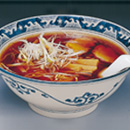
-
Hida-style Chinese
The soup is made in a special way with a mixture of soup and sauce simmered in a cylindrical container. This recipe is unique and does not simply place the sauce in a bowl and then mix it with the soup in the normal way. The soup is made with a base of chicken bones, dried bonito and vegetables and the sauce is made from soy sauce and mirin (type of sweet sake used in cooking). The noodles are also unique - they are finely curled.
-
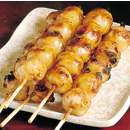
-
Midarashi Dango
These are dumplings that are eaten in the Hida region of Gifu Prefecture. Cold or warm water is added to rice flour and kneaded then it is separated into small balls which are steamed and then speared on bamboo sticks. The dumplings are 3-5cm in diameter. They are warmed a little on a grill, dipped in a soy-based sauce and put back on the grill. When the surface turns brown and there is a fragrant aroma, they are ready to eat.
-
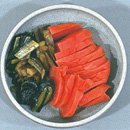
-
Red turnip
Hida red turnip pickles are a Hida region speciality. This is a Hida/Mino traditional vegetable, called a Hida Red Turnip when it is round in shape with a red skin and a white interior and picked when the leaves are soft.
-
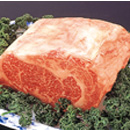
-
Hida Beef
This is beef from Japanese Black cattle raised to over 14 months of age within Gifu Prefecture and graded by the Japan Meat Grading Association with the yield rate class of A/B meat quality with grades from 5-3.
-
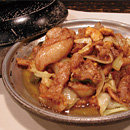
-
Keichan
Keichan is a type of local Gifu Prefecture cuisine using chicken. It began as a home-cooked dish in the 1950s in Gero City (formerly Mashita-gun) in the south of the Hida region, the south of Takayama City and Gujo City in the Okumino region and it is said that, from the 1960s, it single-handedly revolutionized local butcher's shops and bars.
-
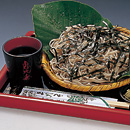
-
Hida Soba
The noodle grains are cultivated on cold high land from 400 - 1000m above sea level. As they grow in a cool climate with a severe difference between day and night temperatures, a fragrant noodle flour is produced.
-
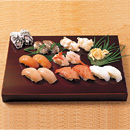
-
Hida Sushi
Even though it is a mountainous area rather than a coastal area, Hida is a good place for sushi. Sample sushi of fresh seafood delivered daily from the Sea of Japan or Hida beef sushi.
-
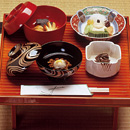
-
Sowa-ryu Honzen Cuisine
Sowa Kanamori, the founder of the Sowa-ryu Way of Tea and the eldest son of Arishige Kanamori, the 2nd feudal lord of Hida Takayama, created the Honzen (extremely high grade Japanese meal served all at once), which is still highly regarded today, to his own taste and format at the beginning of the Edo Period. (Honzen cuisine ⇒ began in the Muromachi Period and developed widely in the Edo Period. It is a style of Japanese cuisine with a particular format and etiquette.)
-
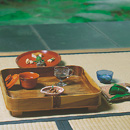
-
Shojin Cuisine
Refined cuisine that does not use any kind of animal protein such as meat or fish.
-
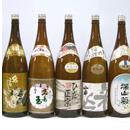
-
Local Hida Sake
Made in an environment blessed with conditions such as pure water, high quality rice and a good climate. There are 8 local sake producers in Takayama City and tasting is also possible.
-
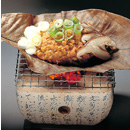
-
Magnolia Leaf Miso
Fallen leaves (dead leaves) from the magnolia tree are spread with home-made miso and spices such as green onions and edible wild plants and mushrooms such as shiitake and cooked. It is a local Hida regional dish that is eaten on top of rice.
-
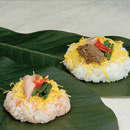
-
Magnolia Leaf Sushi
Young leaves from the magnolia tree (green magnolia) are spread with vinegared rice and sushi ingredients as well as sliced Myoga (type of ginger) or ginger and then wrapped up and left to stand before eating. It is a local Hida regional dish that gives a feeling of the season of summer with the fragrance of the leaves soaking into the rice.

-
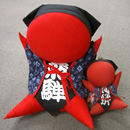
-
Sarubobo
Sarubobo means baby monkey. They are good omens that keep disasters away and keep harmony in the home and are used as talismans. The reason they are red is because red has always been considered to purify evil spirits and to give the blessing of warding off infectious diseases (in particular, smallpox).
-
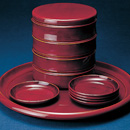
-
Hida Harunori
Capitalizing on the beauty of natural wood grain as it is with a transparent glaze, most examples are yellow or red. It is also light and strong. Items can be roughly divided into 3 categories: flat items (trays, etc.), curved items (sweet boxes, stacking food boxes, etc.) and milled items (saucers, etc.) Techniques for finishing boards three-dimensionally and bending are superior.
-
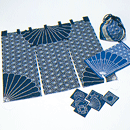
-
Hida Sashiko
This is a handicraft that was born of the wisdom of laying cloth on top of weak cloth to reinforce it. The white cotton thread on the dark blue cloth dyed with indigo is delicate and beautiful. The various patterns are created by each passage of the needle.
-
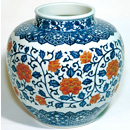
-
Shibukusayaki
Shibukusayaki is a type of porcelain that is produced in Takayama City, Gifu Prefecture. It was first made in the 11th year of the Tempo Period when a pottery was created through cooperation between the government and the people. The raw material is the local Shibukusa pottery stone. While intermingling the characteristics of Seto and Kutani ceramics, unique work called Hida Akae or Hida Kutani was created.
-
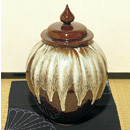
-
Yamadayaki
A simple texture that has been present in everyday life since the Edo Period (Meiwa Era). It is loved as a pottery that fires folk art-style miscellaneous goods and tea utensils.
-
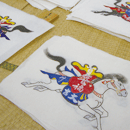
-
Paper Votive Horse
Hida Ema is a paper votive horse. This is a talisman that dates back to the Edo Period and is hung in the entrance hall of the home with the horse's head facing to the interior of the house so that luck does not escape.
-
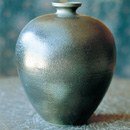
-
Koitoyaki
This porcelain was first created according to the orders of the lord of Takayama Castle in the Edo Period (Kanei Era). It is known as elegant porcelain with an Irabo glaze.
-
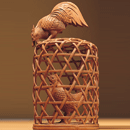
-
Ichi Ito Bori
Ichi Ito Bori is a wooden handicraft of Japanese yew produced in the Hida region of Gifu Prefecture. It begins with choosing good materials and is completed through 6 procedures such as wood cutting. Its charm comes from the increase in the beauty of the wood bark and grain over the years.
-
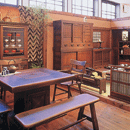
-
Hida Furniture
The high grade woodworking techniques of Mageki (lit. wood bending) and the height of precision are characteristic. This is heavy furniture using solid wood, superior in durability. Hida furniture is highly appreciated within and outside of Japan.
-
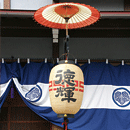
-
Paper lanterns
Japanese paper is pasted to a skeleton that is made from bamboo spokes and carefully proofed with oil. These are essential for Hida festivals.

-
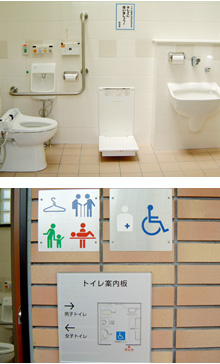
-
Takayama City Barrier-free Town Planning Policy
Aiming for 'welfare town planning where the heart commutes', we are progressing with town planning to make Takayama City a place in which anyone is comfortable living, a calm settled environment in which people want to live and a bustling interactive environment that gives each citizen pride and a purpose in life. Society should be a place in which all people can learn, work and live richly and equally in a community with the concept of 'normalization' as a basic principle to enhance community and residential welfare including welfare facilities so that people with disabilities can live within the community as much as possible and we promote an even higher level of disabled people's welfare policy for independence and autonomous participation in society.
Resolving differences in road levelsDifferences in road levels are a big barrier for people in wheelchairs or the elderly. As a part of lifestyle environment maintenance, we are progressing with resolving the differences in heights between pavements and roads and improving crossroads.
Installing wheelchair access toiletsWe are installing wheelchair access toilets in 80 locations including public toilets in the town, toilets in public buildings, hotels and ryokan. We are also progressing with installing handrails, etc. in existing public toilets.
Manhole lid maintenanceWe are sequentially installing slimline gratings as manhole lids so that the city roads which have a lot of waterways will not hinder wheelchairs.
Wheelchair rentalThere is wheelchair rental for both residents and tourists. However, it should be noted that there are limited numbers so reservations should be made in advance.
Electric baby buggy rentalThere is electric baby buggy rental for both residents and tourists. However, it should be noted that there are limited numbers so reservations should be made in advance.
Installation of a Hida no Sato sightseeing route for wheelchairsElectric wheelchairs can also be rented. The path in the vicinity of Goami pond has been paved so it is now possible for even people who have difficulty walking to sightsee more smoothly.















